Exhibition organised to raise funds for Victoria's Cancer of Heart Treatment
Archive Home Page
Previous Exhibition Following Exhibition
St. Margaret's Hall, Coniston Road, Hatherley, Cheltenham, GL51 3NU
Exhibition organised to raise funds for Victoria's Cancer of Heart Treatment |
Descriptions are based on material supplied by the layout owners
Aimford End This is a fictitious line in the Cotswolds around the 1950’s and 1960’s on the Western Region. Part of this layout was built 40 plus years ago by my father.
I received it in 2019 as a Christmas present from my Grandfather who got it working for me. When I started working on it, it was only track, bridge and a platform. There are details such as a river, discontinues line with workshops in the arches, a farm and hand painted backgrounds. This layout has been exhibited multiple times. | 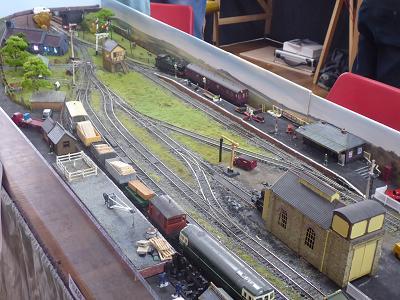 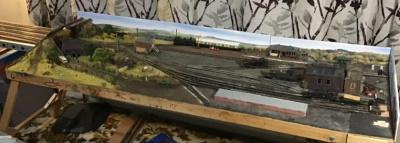 | |
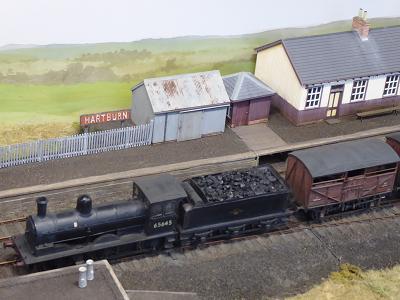  |
Hartburn is a small village in Northumberland. It was never served directly by rail but lay just north of the old Wansbeck Valley Railway from Morpeth to Redesmouth, with the nearest station being Angerton. However, the original plan put forward in 1855 to link Morpeth and Rothbury proposed a line running via Meldon, Hartburn and Longwitton. This proposition pre-dated the Wansbeck Valley. A survey and report was produced by John Willet but nothing came of the project and Rothbury was eventually linked to Morpeth by the Northumberland Central Railway (NCR) that joined the Wansbeck Valley at Scot's Gap. I have therefore based the plan for the layout on the assumption that this original route was built. The track�plan is based upon an amalgamation of the 1862 and 1896 layouts for Angerton. The station buildings are based on those at Brinkworth on the NCR. The layout is set around 1962/3 just prior to closure. Occasional freight trains still pass through on their way to Rothbury hauled mostly by ex�LNER J27s. It is imagined a token passenger service is still in operation, being handled by one of the ubiquitous Metro�Cammell DMUs. The layout started out as a test track that quickly took on a life of its own. It has allowed me to experiment with rural modelling, having for so long modelled urban decay, and also see whether I can survive operating a three turnout layout for two days. | |
Llanteulyddog A West Wales station, circa 1990, coping with emergency engineering diversions. In Medieval times the settlement that was to become Carmarthen was known as Llanteulyddog (St. Teulyddog’s). However, what if history had taken a different course and the River Towy had proved too difficult to bridge, meaning no branch to Lampeter? Llanteulyddog is a small but relatively busy terminus station on a triangular connection with the West Wales main line, served by the usual mixture of DMU, Sprinter and loco hauled passenger trains between Swansea and Milford Haven, Pembroke Dock or Fishguard. Under normal conditions, a small number of freights are seen in the station approaches serving a small terminal operated by Taylor Oils and a concrete hardstanding in the yard, which is used for UKF/Kemira fertilizer trains, the loading of logs for transport to Chirk, and other ancillary Speedlink wagonload traffic. It also sees the overnight stabling and servicing of shunters employed in the Kidwelly area. However, these are not normal conditions! What we see today is Llanteulyddog having to cope with the impact of a significant track defect on the mainline that is forcing all traffic to use the ‘Dog Leg’ Triangle, with all of the freight trains serving the refineries, MoD facilities and ports of West Wales, as well as the traffic for the little known nuclear complex at Abercastle and its new build construction project, using the station area to reverse and continue their journey west or east.
The local signalman, ‘Owens the Signal’, has never been so busy and ‘spotters’ are in for a treat! | 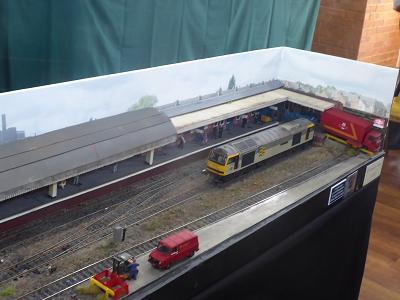 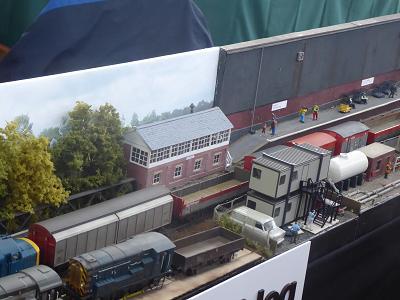 | |
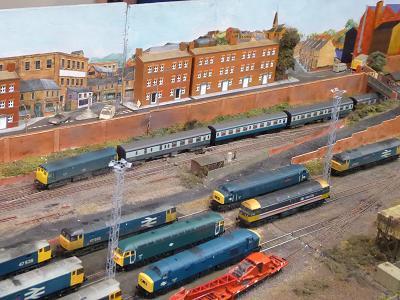 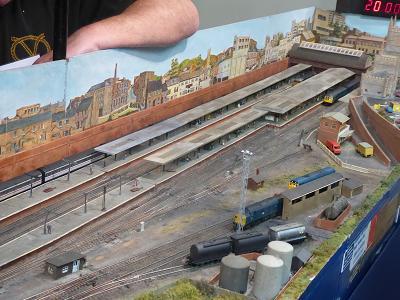 |
Set in the early 1980's the layout represents a terminus station in a fictional large town south of Birmingham, close to the Western Region and London Midland Region boundary and connected to the main line by a triangular junction near the real life station of Kings Norton. This location was chosen because it seemed to give the maximum amount of interesting and varied passenger train workings together with justification for a small locomotive depot providing servicing facilities for freight locomotives allocated to Bescot and Saltley sheds as well as for passenger locomotives laying over between duties. A revised version of the Domesday Book shows the hamlet of Mellinge Forde where there was not very much to speak of; however during the Industrial Revolution local resources of clay, coal and iron attracted investment in first the canals then the railways, both the Midland Railway (MR) and the Great Western Railway (GWR) competing for business. The GWR line ran past the outskirts of the town and was closed during the 1960's as part of the Beeching cuts, but before it shut you may have seen it in the factual documentary about the GWR operating practices called The Titfield Thunderbolt. The Midland/ London Midland Scottish line, which runs into the centre of the town however, continued to prosper, survived the cuts and that is what you see modelled here. The town is large enough to warrant regular calls by Intercity Cross Country trains together with loco hauled provincial routes and DMU services between Birmingham and Worcester, operating to a sequence based in a British Rail 1982 timetable. Light engines working on and off shed also appear. The star performers are mainly blue diesel, for which the layout owners have a soft spot! These include the now historic class 25's, 40's and 50's. Visiting shows as both exhibitors and paying punters gives us the impression that this is a much under modelled period of British railway history. The operating sequence is governed by over 460 cards shared between two operators, each card showing both the train movements and the necessary electrical set up for the train to actually move, hopefully. There are 17 points and 28 switches to provide scope for any lurking gremlins. The whole sequence can take in excess of 6 hours to run through. The baseboards are built in the standard way using plywood, glues and screwed together. The station building is scratchbuilt and is a closely detailed representation of Bristol Temple Meads, other buildings are eith scratchbuilt or modified kits from the Kestrel and Peco ranges. Rolling stock is largely from Graha Farish range and is usually weathered and renumbered, dome of the coaching stock have TPM inlays fitted abd suitably modified roofs and underframes. Other detail items have come from various sources. We hope you enjoy looking at our model and if you have any questions about it we will endeavour to answer them. | |
Marshleigh Marshleigh Wagon Repair Depot is set in present day Wiltshire, specifically from around 2010 onwards. It is based in a fairly rural location but is supposedly near to a larger, busier marshalling yard. The principle of operation is based on the many wagon repair depots around the UK where wagons are taken on short "trip workings" to be repaired. These services are occasionally seen arriving at Marshleigh hauled by a mainline locomotive. The wagons are then shunted around the yard ready to be repaired. The majority of the rolling stock comprises of ex British Rail civil engineering wagons - these are frequently seen in the real area at places such as Westbury and Eastleigh. The layout was started in November 2021 as a small scene to run my collection of modern image rolling stock. Being 5 feet long it is easily transported as one piece. The wagons themselves are a mixture of ready to run, kit built and scratch built to represent a wide variety of modern image engineering stock. They have all been suitably weathered using acrylics, washes and airbrushing based on real images. The scenery is built using products from Woodland Scenics, Green Scene, Javis, including turf, scatter, static grass and polyfibre. I have used Dapol's Pothole Road kit to create the tarmac areas. The buildings are all kit built or scratch built using plastic sheets and styrene section. The track is Peco code 100 concrete and runs on DCC. Some locomotives are sound fitted. They are all in various stages of completion in terms of their weathering and DCC fitting. |  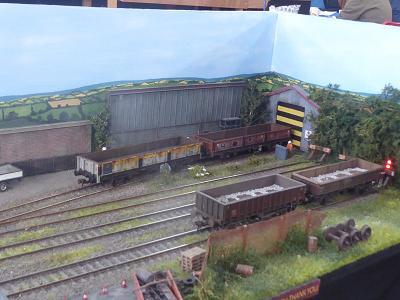 | |
  |
Morfa Mawr was originally planned as part of a narrow gauge line by the Vale of Rheidol Railway and despite later plans for a standard gauge railway submitted by the LA&NQLR it would only be built by the Cambrian Railway – albeit with a few deviations including running the line into Newquay crossing the Lampeter to Aberaeron line at Crossways. Work finally started in 1911 with completion just before the Great War and operations by the Great Western Railway. The layout was based circa 1970 on the coast of Cardigan Bay near Llanon between Aberystwyth and Aberaeron and consisted of a small single platform station with run round sidings for goods and coal. The later additional siding accommodated the provender shed. EM gauge Morfa Mawr measured 12’ x 18" with an 8’ scenic section and a 4’ sector plate fiddle yard at the southern end. Another northern fiddle yard would be a future possibility and he layout could be controlled either by traditional dc or by DCC. | |
Rannoch Our layout, Rannoch, was built by Mike Harries, one of our members, in the 1980's. He was inspired to model this remote station, a passing place on the West Highland Line, after reading John Thomas's book on the history of the line. The club has taken Mike's model and brought it up to date taking advantage of some of the currently available rolling stock suitable for the line. The layout is built using conventional N gauge techniques, Peco track and point motors and is operated in DC mode. The advantages of N gauge allow us to show the scenic openness of the area and have a compact through fiddle yard behind the layout. A good selection of trains are normally run from the blue British Railway period with leanings towards a slightly more modern era. | 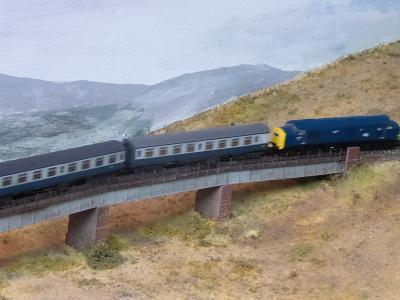 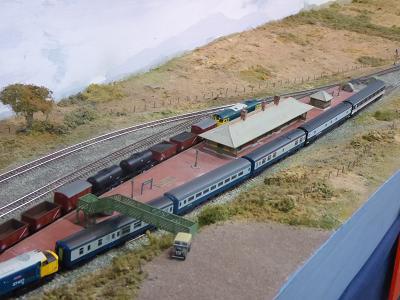 | |
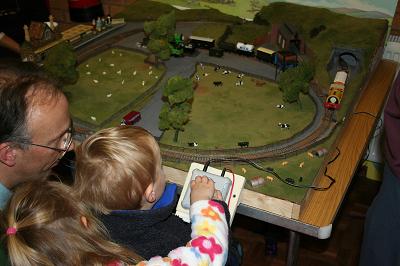 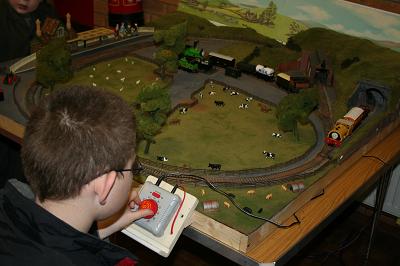 |
We would like to thank Trevor Hallam for looking after the Thomas Layout for many years at our exhibitions and also for refurbishing it at his expense. Unfortunately because of ill health Trevor is no longer able to continue so it was decided to offer Thomas free of charge to Hucclecote Railway Modellers on condition they bring it to all of our future exhibitions. This is the model railway where Children can become Engine Drivers on the Island of Sodor and has of course been inspired by the Reverend Audrey books. Our Thomas and Friends layout has been built for ten years now and in that time we hope it has encouraged many new railway enthusiasts to build a train set of their own. Originally it was intended as a space filler at shows so needed to be small, easy to transport and have a simple track plan, easy for small children to operate. After its first appearance it was clear this model railway would have to be included at all our exhibitions. It incorporates a tunnel, station, level crossing together with locomotive and goods facilities. Train drivers should look out for many of the popular characters; Henry, Percy, Toby, Cranky, the Troublesome Trucks, not forgetting the Sir Topham Hatt better known as the Fat Controller. The famous anthropomorphised rolling stock is mostly from the Thomas range and we are sure most of the adults and all the kids will love it. Happy Driving, but please observe the track speed limits. | |
Thursley Thursley is the name given to our club's new O gauge layout. It is a small branch terminus inspired by, but not based on Dursley, which had a similar very constricted site. The period modelled is the early years of nationalisation, when there was still a good deal of stock around which had not yet been through the British Railways paint shop so was still in pre nationalisation "big four" liveries, in various states of dilapidation. Ex London Midland Scottish (LMS) and Great Western Railway (GWR) locomotives prevail. There may well also be the occasional time travelling diesel to allow members' own stock to stretch its legs. Trackwork is all by Peco and control is DCC, using NCE Powercabs. Couplings are Dinghams, which in principle allow automatic coupling with uncoupling by electromagnet. These were adopted as collectively, members' eyesight was no longer up to coping with three link couplings.
Locomotives are all current ready to run offerings, while the goods rolling stock is from kits assembled as a team effort by several club members. Please feel free to ask the operators any questions you have about how one goes about planning and building a layout like this. Things worth looking at are the point rodding, working signals and the fully modelled interior goods shed. | 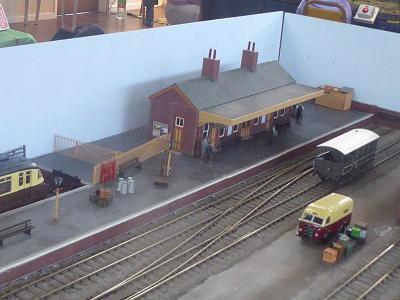  | |
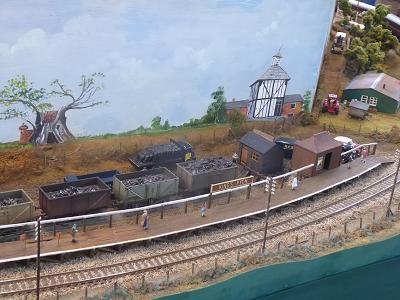 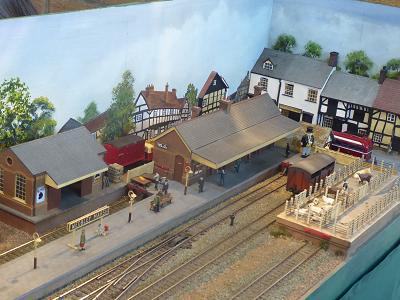 |
Situated on the main line from Hereford to Leominster, north of Moreton-on-lugg is a line to some sidings for a Ministry of Defence Army depot - Circa 1960 to 1975 (British Railways-Western Region). In the Victorian era a branch was built towards Weobley and ended outside the town at a place called Weobley Marsh. The layout is a fictional "could have been". Some of the buildings on the layout are copies of originals from around the town. The back scene shows others from the area. | |
| Displays | ||
Model Bus Federation WEBSITE | NARTM (road transport) WEBSITE | |
Travel 2000 Ltd | BRS Depot | |
Gloucestershire Warwickshire Railway WEBSITE | Bob's 3D Models | |
Millbank: tank duel WEBSITE | 2874 Society | |
| Modelling Demonstrations | ||
| Mark Begley | Richard Self | |
| Steve Harrod | Trevor Hale | |
| Trade | ||
| Collett's Models of Exmouth WEBSITE | Penduke Models WEBSITE | |
| Pre-owned Model Railways, S Parry | Rly books, timetables, photos, Stewart Blencowe WEBSITE | |